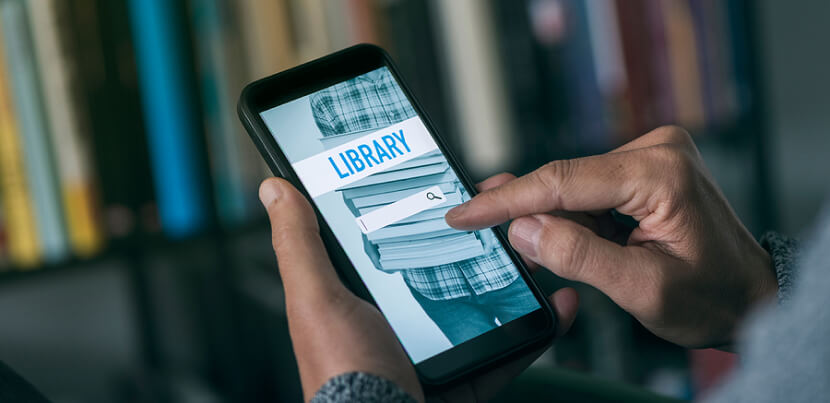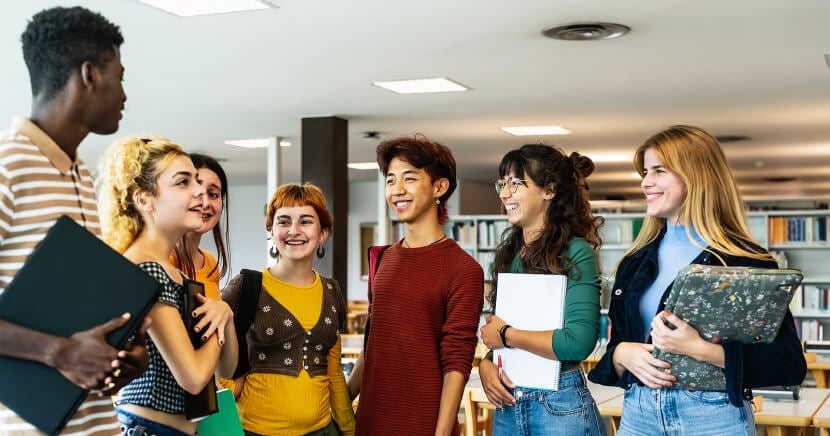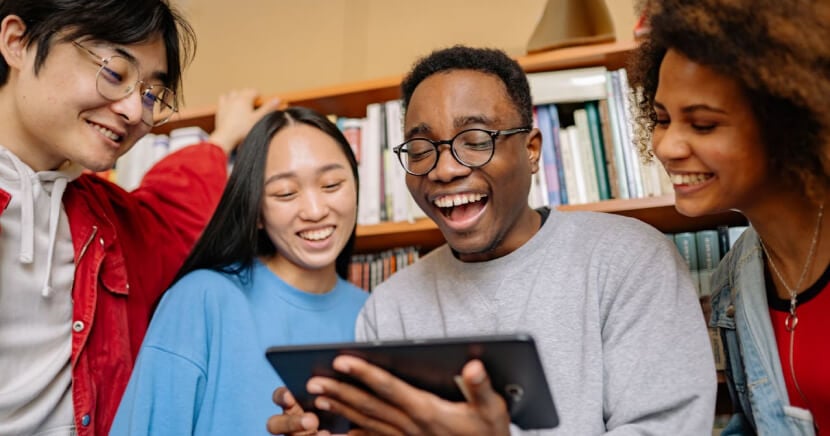As we have explored in a number of our blog posts, the role of the public library is an ever-evolving one. It’s fair to say, in fact, that libraries serve a number of different, but equally vital, functions in our modern communities.
There’s their traditional job as repositories of books and other sources of information and entertainment, of course, but today’s libraries are much more than that. The local library often acts as a community hub, supporting members’ health and well-being and helping them stay informed about such vital topics as media literacy and environmental sustainability.
You could even argue — as sociologist Eric Klinenberg did in his 2019 book Palaces for the People — that the public library is a critical part of building the essential “social infrastructure” of civic life.
See also:
-
Four library technology trends shaping the future of public libraries
-
Equity and access to information: Libraries have a role to play
-
National Library Week highlights the role of libraries in our digital age
Bridging the digital divide
One of the vital roles that libraries play is in bridging the “digital divide”, which refers to the gap between those who have access to technology (including broadband internet) and those who do not.
In 2021, United Nations Deputy Secretary-General Amina Mohammed warned the UN General Assembly, “As the world becomes more digitally dependent, it threatens to exclude those that remain disconnected. Almost half the world’s population, 3.7 billion people, the majority of them women, and most in developing countries, are still offline.”
Even in more developed countries such as the United States and Canada, this digital divide persists, particularly for low-income individuals, seniors and residents of rural communities.
Fortunately, by offering a range of digital devices and services, libraries can help visitors access tech tools, improve their digital literacy and computer skills, get on the web and learn to navigate the internet safely.
Lack of access is a challenge
One of the biggest challenges facing underserved communities is a lack of access to technology, which can lead to limited technological capital. According to data from Pew Research Center, nearly a quarter of Americans do not have high-speed internet access, with those in rural areas and low-income households being disproportionately affected.
In fact, only 57% of households with incomes less than US$30,000 per year have home broadband internet access, compared to 92% of households with incomes greater than US$75,000 per year.
A survey by the National Telecommunications and Information Administration (NTIA) found that, while 58% of the offline households in the US express no interest or need to be online, there is also a large proportion (18%) who say they can’t afford a home internet connection (18%).
"Regardless of their stated reasons for non-use, offline households have significantly lower incomes than their online counterparts," the NTIA reports. "This suggests that even after overcoming other barriers, cost may be an additional challenge for many offline households."
Broadband bridges the urban-rural divide
Tim Kuelker is the manager of technology services and infrastructure at the Northern Lights Library System, a regional library system serving nearly 50 independent public libraries in rural communities across the province of Alberta.
In an article in the May 2024 issue of Computers in Libraries, Kuelker discussed the urban-rural divide in Canada. In 2016, he noted, the Canadian Radio-television and Telecommunications Commission (CRTC) set a nationwide service objective for broadband quality:
It outlined a basic service objective of 50Mbps of download speed and 10Mbps of upload speed — now commonly referred to as 50/10 — setting a precedent for not only the capacity and quality of internet connections for households in Canada, but the accessibility of internet connections as well, particularly in rural communities. Most importantly, it outlined broadband connectivity as an essential service.
Kuelker writes that, by 2022, only 42% of rural households in Alberta were able to attain the minimums targeted in this policy in 2022, which he points out is the the lowest of any Canadian province.
"To librarians," Kuelker writes, "this prompts the question of the role that public libraries can play in addressing this issue. Public libraries have traditionally been institutions that work to address inequalities, particularly regarding access to information.
To meet the service objective of 50/10 set by the CRTC in 2016, Kuelker and his team would need to increase bandwidth at their libraries a staggering 900%:
Admittedly, this was an ambitious target.... But within one year of arriving at the Northern Lights Library System, my team and I were able to secure funding to bring our first increase in bandwidth to these libraries, resulting in a 300% increase in internet speeds for the majority of our libraries. It was a huge step toward bridging the digital divide for communities in rural Alberta.
How libraries bridge the digital divide

Lack of internet access can make it difficult for individuals to apply for jobs, complete schoolwork, access government services and stay connected with family and friends.
Public libraries are helping to address this digital divide by providing free internet access, as well as WiFi hotspots that members can borrow and use at home.
This is particularly important for individuals who may not have reliable internet access at home, or who need the ability to work or study remotely.
Keeping communities connected in a pandemic
Before COVID-19, we already lived in a hyper-connected world, with affordable internet access impacting everything from job hunting and working, to getting up-to-date news and information, and even accessing quality education.
The pandemic only intensified this, making the online world an even greater part of our reality. According to UNCTAD’s Digital Economy Report 2021 the COVID-19 pandemic increased internet traffic by a whopping 35% in 2020.
A 2022 American Library Association report highlighted the crucial role that librarians and their institutions played in keeping community members connected during the COVID-19 pandemic.
COVID exacerbated already existing digital divides, and when brick-and-mortar branches were closed it left a substantial gap that needed to be addressed immediately.
According to the ALA report, "Library staff responded quickly to the unfolding public health crisis, leveraging their knowledge of local connectivity gaps and community needs to partner with community organizations, local governments, and businesses to offer broadband service."
Providing access to essential tech
Per the ALA, libraries kept their communities connected during COVID lockdowns by:
-
Strengthening wireless signals and extending activation hours, so people could access WiFi from outside library buildings
-
Partnering with local government, businesses, and community organizations to set up additional outdoor and drive-in WiFi hotspot locations
-
Using library vehicles to bring hotspots to neighborhoods in need of connectivity at advertised times
-
Targeting hotspots to specific populations — homeless, veterans and low-income families, for example
-
Providing tech support and digital-skills help by phone
-
Adapting in-person workshops to be held online
-
Offering curbside printing, faxing and copying services
-
Partnering with digital equity organizations, community leaders and service providers to provide broadband access and reduce barriers
Above and beyond access to the internet
In addition to internet access, libraries also offer a range of digital resources, including eBooks, audiobooks and digital news platforms including PressReader. These resources can be particularly beneficial for individuals who may not have access to physical books or who have difficulty getting to a library due to transportation challenges.
Libraries can also play a key role in providing access to technology that may be too expensive for individuals or families to purchase on their own. For example, some libraries loan out laptop computers or tablets to their members.
This can be particularly important for students who need technology to participate in remote learning or for people who are job-hunting and need access to the internet so they can apply for positions online.
Digital literacy and internet safety
Another important aspect of bridging the digital divide is promoting digital literacy skills. Many individuals in the community, particularly seniors, may not feel comfortable using computers or may not have the skills to navigate the internet safely.
Libraries can offer digital literacy programs and one-on-one assistance to help patrons build their skills and confidence. This can include providing quality education in basic computer skills, showing library patrons how to use social media or email, and discussing internet safety and cyberbullying prevention.
A generation gap in technology
Digital literacy is inextricably linked to media literacy. People of all ages can benefit from looking at all of the messages they receive online, whether from social media, blogs or news websites, with a more critical eye.
The fact is, however, that there is a distinct generation gap when it comes to technological literacy, and it is members of older generations who are at the most risk.
If they lack the techniques necessary to spot misinformation online, as McAfee points out, “Older adults can easily fall prey to scams, conspiracies, hoaxes, and false news stories online.”
The benefits of digital literacy

Librarians can give their older users a solid grounding in the basics of navigating the digital world, and then support them as they deepen their knowledge on their own by exploring interactive web-based programs such the Poynter Institute’s self-paced MediaWise for Seniors.
Researchers at Stanford University used that program as the basis for a study of the effectiveness of media-literacy education in older people.
The researchers found that “The older adults who took the MediaWise for Seniors intervention showed an improved ability to accurately classify true and false news after taking the course, displayed greater comprehension of several skills important for identifying misinformation online, and were more likely to report doing research on news stories before making judgments about their veracity.”
The study’s authors reported that participants in media-literacy education courses improved their skill in accurately discerning disinformation from true news from 64% pre-intervention to 85% post-intervention.
Equity in digital access
By offering a range of digital resources and services, libraries are helping to decrease the digital divide and promote equity in technology access. However, it is important to recognize that there is still much work to be done to ensure that all individuals have the same opportunities and access to the essential resources they need to thrive.
As Tim Kuelker observes:
The complexity of this issue defies a single solution. Rural public libraries and systems are left to chart their own course in the pursuit of providing reliable high-speed internet services. It’s a daunting and costly endeavor, but as modern-day librarians, it is incumbent upon us to rise to the challenge. Just as we’ve adapted to evolving technological landscapes, we must now advocate and innovate to ensure that no community is left behind in the digital age.
By continuing to invest in public libraries and support their efforts to expand technology access and funding their initiatives to promote digital literacy, we can work towards a more equitable and connected world.









